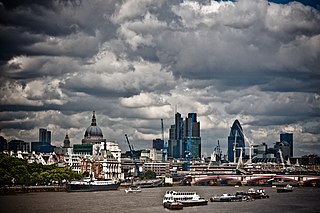Liquidation is the process in accounting by which a company is brought to an end in Canada, United Kingdom, United States, Ireland, Australia, New Zealand, Italy, and many other countries. The assets and property of the company are redistributed. Liquidation is also sometimes referred to as winding-up or dissolution, although dissolution technically refers to the last stage of liquidation. The process of liquidation also arises when customs, an authority or agency in a country responsible for collecting and safeguarding customs duties, determines the final computation or ascertainment of the duties or drawback accruing on an entry.
Wrongful trading is a type of civil wrong found in UK insolvency law, under Section 214 Insolvency Act 1986. It was introduced to enable contributions to be obtained for the benefit of creditors from those responsible for mismanagement of the insolvent company. Under Australian insolvency law the equivalent concept is called "insolvent trading".
In company law, fraudulent trading is doing business with intent to defraud creditors.
In law, a liquidator is the officer appointed when a company goes into winding-up or liquidation who has responsibility for collecting in all of the assets under such circumstances of the company and settling all claims against the company before putting the company into dissolution. Liquidator is a person officially appointed to 'liquidate' a company or firm. Their duty is to ascertain and settle the liabilities of a company or a firm. If there are any surplus, then those are distributed to the contributories.

United Kingdom insolvency law regulates companies in the United Kingdom which are unable to repay their debts. While UK bankruptcy law concerns the rules for natural persons, the term insolvency is generally used for companies formed under the Companies Act 2006. "Insolvency" means being unable to pay debts. Since the Cork Report of 1982, the modern policy of UK insolvency law has been to attempt to rescue a company that is in difficulty, to minimise losses and fairly distribute the burdens between the community, employees, creditors and other stakeholders that result from enterprise failure. If a company cannot be saved it is "liquidated", so that the assets are sold off to repay creditors according to their priority. The main sources of law include the Insolvency Act 1986, the Insolvency Rules 1986, the Company Directors Disqualification Act 1986, the Employment Rights Act 1996 Part XII, the Insolvency Regulation (EC) 1346/2000 and case law. Numerous other Acts, statutory instruments and cases relating to labour, banking, property and conflicts of laws also shape the subject.

Re MC Bacon Ltd [1990] BCLC 324 is a leading UK insolvency law case, concerning transactions at an undervalue and voidable preferences.

Re Barleycorn Enterprises Ltd [1970] Ch 465 is a UK insolvency law case, concerning the priority of creditors in a company winding up. It was held that fees for liquidation came in priority to preferential claims and floating charges. This was overturned by the House of Lords in Buchler v Talbot, but reinstated by Parliament through an amendment to the Insolvency Act 1986 s 176ZA.

Re Parkes Garage (Swadlincote) Ltd [1929] 1 Ch 139 is a leading UK insolvency law case, concerning a voidable floating charge for past value.

Re Gray’s Inn Construction Co Ltd [1980] 1 WLR 711 is a leading UK insolvency law case, concerning the cessation of transactions without court approval after a winding up petition.

Re Anglo-Austrian Printing & Publishing Union [1895] 2 Ch 891 is a UK insolvency law and company law case, concerning recovery of assets under a misfeasance action. It was held that because the claims were vested in the company before the company went into liquidation, the proceeds of such a claim would be caught by a floating charge where the floating charge was expressed to include any after-acquired property.

Re Oasis Merchandising Services Ltd [1998] Ch 170 is a UK insolvency law and company law case, concerning wrongful trading.

Buchler v Talbot[2004] UKHL 9 is a UK insolvency law case, concerning the priority of claims in a liquidation. Under English law at the time the expenses of liquidation took priority over the preferred creditors, and the preferred creditors took priority over the claims of the holder of a floating charge. However, a crystallised floating charge theoretically took priority over the liquidation expenses. Accordingly the courts had to try and reconcile the apparent triangular conflict between priorities.

Cayman Islands bankruptcy law is principally codified in five statutes and statutory instruments:
Australian insolvency law regulates the position of companies which are in financial distress and are unable to pay or provide for all of their debts or other obligations, and matters ancillary to and arising from financial distress. The law in this area is principally governed by the Corporations Act 2001. Under Australian law, the term insolvency is usually used with reference to companies, and bankruptcy is used in relation to individuals. Insolvency law in Australia tries to seek an equitable balance between the competing interests of debtors, creditors and the wider community when debtors are unable to meet their financial obligations. The aim of the legislative provisions is to provide:
Provisional liquidation is a process which exists as part of the corporate insolvency laws of a number of common law jurisdictions whereby after the lodging of a petition for the winding-up of a company by the court, but before the court hears and determines the petition, the court may appoint a liquidator on a "provisional" basis. Unlike a conventional liquidator, a provisional liquidator does not assess claims against the company or try to distribute the company's assets to creditors, as the power to realise the assets comes after the court orders a liquidation.

Hong Kong insolvency law regulates the position of companies which are in financial distress and are unable to pay or provide for all of their debts or other obligations, and matters ancillary to and arising from financial distress. The law in this area is now primarily governed by the Companies Ordinance and the Companies Rules. Prior to 2012 Cap 32 was called the Companies Ordinance, but when the Companies Ordinance came into force in 2014, most of the provisions of Cap 32 were repealed except for the provisions relating to insolvency, which were retained and the statute was renamed to reflect its new principal focus.

Stichting Shell Pensioenfonds v Krys[2014] UKPC 41 was a decision of the Privy Council on appeal from the British Virgin Islands relating to an anti-suit injunction in connection with an insolvent liquidation being conducted by the British Virgin Islands courts.

Ayerst v C&K (Construction) Ltd [1976] AC 167 was a decision of the House of Lords relating to revenue law and insolvency law which confirmed that where a company goes into insolvent liquidation it ceases to be the beneficial owner of its assets, and the liquidator holds those assets on a special "statutory trust" for the company's creditors.

Brooks v Armstrong[2016] EWHC 2289 (Ch), [2016] All ER (D) 117 (Nov) is a UK insolvency law case on wrongful trading under section 214 of the Insolvency Act 1986.

Re Yagerphone Ltd [1935] 1 Ch 392 was a United Kingdom insolvency law decision relating to unfair preferences and the proceeds of any claims by a liquidator for unfair preferences, and in particular determining the priority of claims between the general body of creditors and the holder of a floating charge.













